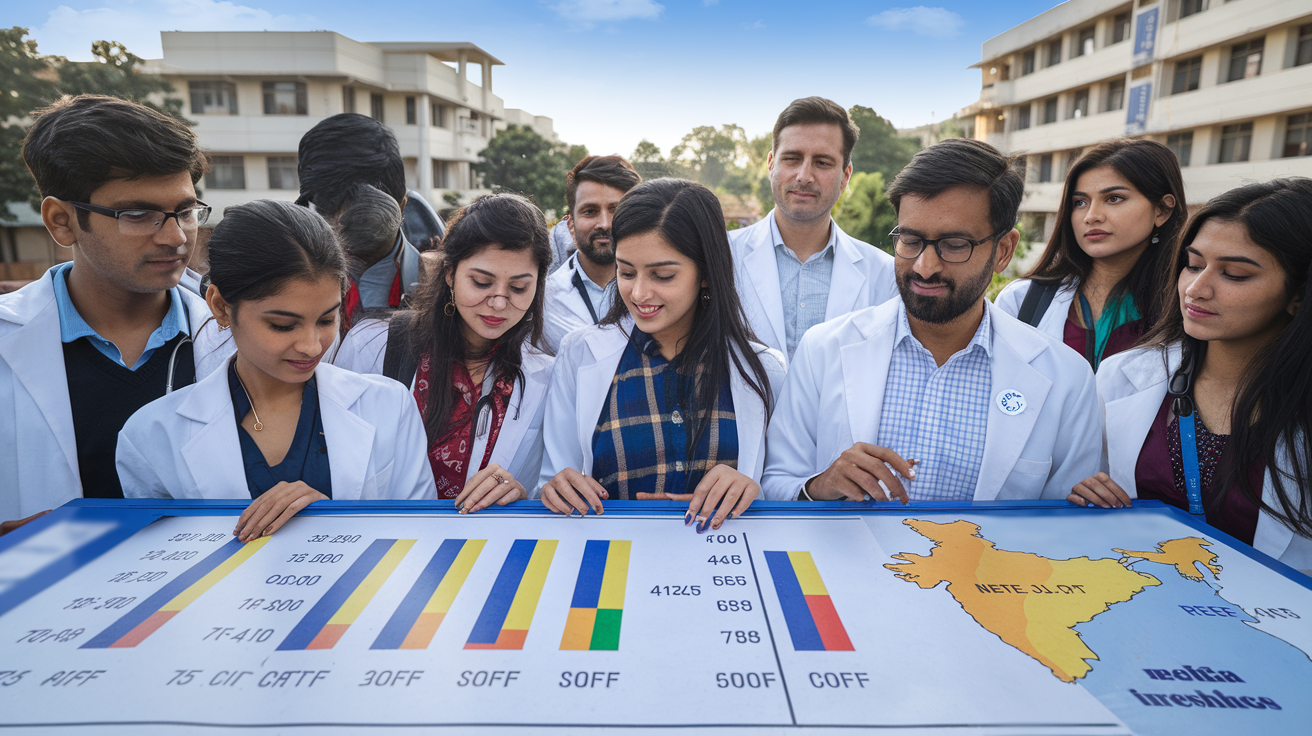NEET State-wise Cut off 2025: Check easiest states to get MBBS Admission Category Wise
Are you among the 22.7 lakh NEET aspirants anxiously wondering which states offer your best shot at an MBBS seat in 2025? The journey to medical college can feel like navigating a maze, with each state having its own unique cut-off scores that could make or break your dreams of becoming a doctor. With the National Testing Agency (NTA) set to release the official NEET 2025 cut-offs in June, understanding which states have historically lower thresholds could be your strategic advantage in securing that coveted medical seat. 🎯
The truth is, not all states are created equal when it comes to NEET cut-offs. While some competitive regions demand near-perfect scores, others offer more accessible pathways to medical education—especially when you factor in category-wise reservations. Your NEET score might be insufficient in one state but perfectly adequate in another! This crucial difference could determine whether you’ll be wearing that white coat next year or preparing for another attempt. The expected cut-off range for general category candidates in 2025 is projected between 720-162, with potentially lower thresholds compared to last year’s challenging exam.
In this comprehensive guide, we’ll walk you through everything you need to know about NEET state-wise cut-offs for 2025, breaking down the difference between All India Quota and State Quota systems, analyzing the factors that influence these thresholds, providing a detailed state-by-state comparison, and offering strategic approaches to maximize your chances during the medical college application process. Let’s dive in and discover your most promising pathway to that MBBS degree! 📚💉
Understanding NEET State-wise Cut-off for 2025

Understanding NEET State-wise Cut-off for 2025
Difference between NEET qualifying marks and admission cut-off
As you prepare for NEET 2025, it’s crucial to understand the fundamental difference between qualifying marks and admission cut-offs:
-
Qualifying Cut-Off: This represents the minimum score you need to be eligible for the counseling process. Meeting this threshold merely makes you eligible to apply for medical courses but doesn’t guarantee admission.
-
Admission Cut-Off: These are the actual scores required for securing admission to specific medical colleges. Admission cut-offs vary significantly by institution and candidate category, and are typically much higher than qualifying cut-offs.
This distinction is vital for your strategic preparation, as aiming for merely qualifying scores may not be sufficient for securing a seat in your preferred medical college.
Expected cut-off ranges for General, SC, ST, and OBC categories
Based on previous trends and considering the evolving competitive landscape, here are the expected qualifying cut-off ranges for NEET 2025 across different categories:
- General (UR) Category: 140-720 marks
- OBC Category: Expected to show a similar upward trend from 2024 cut-offs
- SC Category: Expected to show a similar upward trend from 2024 cut-offs
- ST Category: Expected to show a similar upward trend from 2024 cut-offs
For reference, NEET 2024 qualifying cut-offs for General category ranged from 137-720 marks, with variations for other categories as well. The expected slight increase in 2025 cut-offs reflects the continuously evolving competitive landscape.
Impact of increased competition on 2025 cut-offs
The competition for NEET 2025 is projected to intensify, which will directly impact cut-off scores across states:
- High-demand states like Delhi are anticipated to have extremely competitive cut-offs exceeding 680 marks for government colleges
- States like Bihar and Tamil Nadu are expected to have comparatively lower cut-offs, though still competitive
This variation stems from multiple factors including:
- Number of applicants (which continues to rise year by year)
- Difficulty level of the examination
- Availability of seats in government and private medical colleges
- Historical data and performance trends
- Competition across different categories
You should be aware that top government medical colleges such as AIIMS Delhi are projected to have exceptionally high cut-offs, potentially requiring scores above 710 marks for admission.
Role of NTA in determining and announcing official cut-offs
The National Testing Agency (NTA) plays the definitive role in establishing and publishing the official NEET cut-offs. Here’s what you should know about their process:
- The NTA analyzes overall student performance after the examination
- They consider the difficulty level of the exam in a particular year
- They take into account the number of available seats across medical institutions
- The official cut-offs are announced only after the examination is conducted
It’s important that you don’t stress excessively over predicted cut-offs. While these predictions serve as useful guidelines for your preparation, the final authority rests with the NTA’s official announcement.
Rather than fixating on cut-off predictions, focus your energy on consistent preparation through mock tests and regular study. Your performance in practice tests will give you a better indication of your readiness and potential rank.
Now that we’ve covered the fundamental aspects of NEET state-wise cut-offs for 2025, including the distinction between qualifying and admission cut-offs, expected ranges for different categories, impact of competition, and the NTA’s role, let’s examine the critical differences between All India Quota and State Quota systems and how they affect your chances of securing a medical seat.
All India Quota vs. State Quota System

All India Quota vs. State Quota System
Now that we understand the NEET state-wise cut-offs for 2025, it’s essential to grasp the two primary admission pathways that determine how these cut-offs apply to your medical journey. The NEET counseling process divides seats into two main quotas, each with its own set of rules and opportunities.
A. 15% All India Quota seats managed by MCC
The All India Quota (AIQ) represents 15% of the total available seats in government medical colleges across India. These prestigious seats are managed by the Medical Counselling Committee (MCC) under the Directorate General of Health Services (DGHS). What makes the AIQ special is that it allows you to compete for seats in top institutions like AIIMS and PGIMER, regardless of your state of domicile.
To be eligible for AIQ seats, you need:
- A competitive All India Rank (AIR) in NEET UG 2025
- Completion of Class 12 with minimum 50% marks in science stream from a recognized board
The competition for AIQ seats is significantly higher as you’ll be competing with candidates from across the nation, resulting in higher cut-off marks. These seats follow the central reservation policy for categories like SC, ST, OBC, and EWS.
B. 85% State Quota seats and domicile requirements
The State Quota accounts for the majority—85% of total seats—covering both government and private medical colleges within each state. This is where understanding state-wise cut-offs becomes crucial for your admission strategy.
Key points about State Quota seats:
- Eligibility criteria vary from state to state, with each having its own domicile requirements
- Cut-off percentages differ based on local regulations and competition
- You must typically possess a valid domicile certificate for the state whose quota you’re applying to
- Competition is generally lower compared to AIQ, benefiting local candidates
The State Quota system ensures that local students have greater opportunities to secure admission in their home states, with typically lower cut-offs compared to the AIQ.
C. Counseling processes for different quotas
The counseling mechanisms for AIQ and State Quota follow different procedures:
For AIQ seats:
- Counseling is conducted by the MCC on behalf of the DGHS
- Registration must be completed on the official MCC website
- The process typically begins after NEET results are declared
- Candidates are allocated seats based on their rank, choices, and reservation category
For State Quota seats:
- State counseling authorities handle the admission process
- You need to register separately on your respective state’s official medical counseling website
- State quota counseling usually commences after the completion of AIQ admissions
- Each state follows its own reservation policies, which might include horizontal reservations in some states
Importantly, you can apply for both quotas simultaneously, maximizing your chances of securing a medical seat.
D. Importance of state-specific cut-offs in admission planning
Understanding state-specific cut-offs is critical when planning your NEET 2025 admission strategy. Here’s why:
- Different states have varying levels of competition, resulting in diverse cut-off trends
- Some states may offer more accessible entry points based on your expected NEET score
- Your category (General, SC, ST, OBC, EWS) will significantly impact the applicable cut-off
- State quotas provide 5.67 times more seats than AIQ, offering greater opportunities especially for candidates with state domicile
When developing your application strategy, you should:
- Evaluate your expected NEET rank against historical state cut-offs
- Consider your domicile state’s policies and competition level
- Assess potential benefits from reservation categories in different states
- Weigh your preferences for specific institutions against the likelihood of admission
With this understanding of how the quota system works, your next step is to explore the various factors that influence these state-wise cut-offs. These factors will help you predict and prepare for the competitive landscape of NEET 2025 admissions.
Factors Affecting State-wise Cut-offs

Factors Affecting State-wise Cut-offs
Now that we’ve explored the distinction between All India Quota and State Quota systems, let’s examine the critical factors that influence NEET state-wise cut-offs for 2025. Understanding these elements will help you develop a strategic approach to your medical college applications.
A. Number of available seats in each state
The total number of MBBS seats across India significantly impacts the NEET cut-offs in different states. With approximately 91,415 MBBS seats nationwide, the competition remains intense. States with a higher number of medical colleges naturally offer more seats, potentially resulting in more accessible cut-offs.
You should note that the seat-to-applicant ratio is a crucial determinant. With an expected 23 lakh candidates appearing for NEET 2025, you’re competing with approximately 25 students for each available seat. States with better seat distribution relative to their applicant pool typically present lower cut-offs, making them strategically important in your application process.
B. Category-wise reservations and their impact
Reservation policies significantly influence the NEET 2025 cut-offs across different states. For the general category, you can expect the qualifying marks to range between 720 and 162, corresponding to the 50th percentile (715-120 marks). If you belong to SC/ST/OBC categories, the qualifying threshold drops to the 40th percentile (120-100 marks).
These category-wise variations create different competitive landscapes within each state. For instance:
- General category students face the highest cut-offs
- SC/ST candidates typically need to achieve between 161 and 127 marks
- OBC and other reserved categories have their specific thresholds
The implementation of reservation policies varies by state, directly affecting your chances of securing admission based on your category. You should carefully review the specific reservation percentages in your target states to gauge your prospects realistically.
C. Overall performance of candidates from different states
The collective performance of candidates from various states creates notable disparities in cut-off trends. Historical data indicates that states with better educational infrastructure and coaching facilities tend to produce higher-scoring candidates, subsequently raising the cut-off bars.
Your performance will be benchmarked against others from your state as well as the national pool. The highest marks recorded in previous years provide valuable insights—with the highest score in 2022 being 715. This historical context suggests that the 2025 cut-offs will likely mirror the 2024 range of 720 to 164 marks for general category students.
The difficulty level of NEET 2025, expected to be moderate to difficult based on past trends, will also shape the performance distribution across states. You should monitor the performance trends in your state to better gauge your competitive position.
D. Reputation and demand for medical colleges in specific states
The prestige and perceived quality of medical institutions within each state directly influence cut-off variations. States housing premier medical colleges naturally attract more high-performing candidates, driving up the cut-off scores.
When formulating your application strategy, consider that:
- Highly sought-after medical colleges in certain states consistently maintain higher cut-offs
- Lesser-known institutions in the same states might have more accessible thresholds
- The closing ranks for government medical colleges vary significantly based on reputation
The Medical Counselling Committee (MCC) will announce available seats before each counselling round, expected to begin in the last week of June 2025. This information will help you assess the demand for specific colleges and make informed decisions about your preferences.
With these factors in mind, next, we’ll examine a detailed state-by-state comparison of NEET cut-offs for 2025, providing you with concrete data to inform your application decisions.
State-by-State Comparison of NEET Cut-offs

State-by-State Comparison of NEET Cut-offs
Now that we’ve explored the various factors that influence state-wise cut-offs, let’s dive into a detailed comparison of NEET cut-offs across different states. Understanding these variations will help you make strategic decisions when applying to medical colleges.
States with historically lower cut-offs for MBBS admission
As you prepare for NEET 2025, it’s essential to be aware of states that typically maintain lower cut-off scores, offering you potentially easier pathways to secure MBBS admission. Based on previous years’ trends and the expected pattern for 2025, several states have consistently shown more accessible cut-offs compared to others.
These states present viable options for candidates who score in the mid-range of the NEET examination. With approximately 22.7 lakh candidates competing for limited seats, identifying these states can significantly improve your chances of admission. The expected cut-off for general category students in these states ranges between 162-500, considerably lower than the national average.
When applying to colleges in these states, you should check if you meet the domicile requirements, as the 85% state quota seats are typically reserved for state residents. This strategic approach could help you secure a seat even with a moderate NEET score.
States with most competitive cut-offs
On the other end of the spectrum, several states consistently maintain extremely competitive cut-offs due to factors such as limited seat availability, high-performing candidates, and prestigious medical institutions. In these states, the general category cut-offs can reach as high as 720, making admission highly challenging.
These competitive states typically have a higher number of quality applicants with exceptional NEET scores. You should consider these states in your application strategy only if you are confident of achieving top-tier scores. The intense competition in these states reflects the reputation and demand for their medical colleges.
For the 2025 NEET examination, these competitive states are expected to maintain their high standards, with minimal changes in their cut-off patterns compared to previous years.
Category-wise variation in state cut-offs
When examining state-wise cut-offs, you must also consider the significant variations across different categories. The expected cut-off for general category candidates ranges between 720-162, while for SC/ST/OBC candidates, the thresholds are typically lower to ensure diversity and representation in medical education.
These category-wise variations are consistent across all states, though the exact differences may vary. For instance, in some states, the gap between general and reserved category cut-offs might be more pronounced than in others.
Understanding these category-specific cut-offs is crucial for your admission strategy. If you belong to a reserved category, you should familiarize yourself with the specific cut-offs applicable to your category in different states, as this could substantially impact your chances of securing admission.
Trends in cut-off changes over recent years
The NEET cut-off trends have shown some interesting patterns over recent years. For 2025, experts anticipate a potential decrease from the previous year’s higher thresholds, attributed primarily to the challenging nature of the exam. This projected trend could be beneficial for you as an aspirant.
The cut-off variations aren’t merely random fluctuations; they reflect broader patterns in exam difficulty, candidate performance, and policy changes. By analyzing these trends, you can better gauge the expected cut-off for 2025 and adjust your preparation and application strategy accordingly.
It’s worth noting that while the qualifying cut-offs remain consistent nationwide, the admission cut-offs vary significantly by state. This distinction is crucial for your understanding of how the system works and how to navigate it effectively.
With this comprehensive understanding of state-wise and category-wise cut-off variations, you’re now better equipped to develop a Strategic Approach to Medical College Applications, which we’ll explore in the next section. This knowledge will help you prioritize your college choices based on realistic assessments of your expected NEET score and the historical cut-off patterns across different states.
Strategic Approach to Medical College Applications

Strategic Approach to Medical College Applications
Now that we’ve explored the State-by-State Comparison of NEET Cut-offs, let’s focus on how you can strategically use this information to maximize your chances of securing an MBBS admission. Understanding the nuances of cut-offs across different states enables you to make informed decisions during the application process.
Using state cut-off data for informed college selection
With the NEET State-wise Cut off 2025 data in hand, you can make strategic decisions about where to apply. When reviewing these cut-offs, consider:
- The gap between your NEET score and the previous year’s cut-off for your category in various states
- Trends in cut-off variations over recent years
- Your eligibility for different state quotas based on domicile requirements
Remember that in 2025, you can apply for both All India Quota (AIQ) and state quota simultaneously. This dual approach increases your options, with AIQ covering 15% of government college seats plus all central and deemed university seats, while state quotas encompass 85% of government seats and all private college seats.
Maximizing chances with optimal state choices
To optimize your application strategy:
- Prioritize states where your score comfortably exceeds the cut-off for your category
- Consider states with historically lower cut-offs if you’re flexible about location
- Evaluate the total number of seats available in each state to assess competition levels
- Remember that candidates from Jammu & Kashmir can now participate in AIQ counseling
Be aware that if you’re allotted a seat in AIQ counseling, you must either accept it or exit the process after Round 2, with no seat upgradation permitted thereafter. Any vacant AIQ seats after this round are transferred to state authorities for state quota counseling.
Category-specific strategies for securing admission
Your approach should be tailored to your reservation category:
For General Category candidates:
- Focus on states with higher number of seats and moderate cut-offs
- Consider both government and private colleges to widen your options
For Reserved Category candidates (OBC, EWS, etc.):
- Take advantage of category-specific reservations in both AIQ (with specific quotas for OBC and EWS) and state quotas
- Prepare all required documentation early, including category certificates that will be verified during counseling
For all candidates:
- Keep track of state-specific reservation policies that may affect seat distribution
- Prepare comprehensive documentation including NEET admit cards, scorecards, and any additional certificates required for state counseling such as domicile and income certificates
Navigating the counseling process with cut-off awareness
Understanding the counseling process is crucial for securing your admission:
- Registration: Create accounts on both MCC website (for AIQ) and relevant state counseling websites
- Document verification: Prepare all necessary documents beforehand, including state-specific requirements like domicile proof
- Choice filling and locking: Prioritize colleges based on cut-off trends and your score
- Seat allotment: Allotment happens based on your state rank, domicile status, and choices filled
Be particularly careful during choice filling – if you fail to lock your choices, the system will automatically lock your last saved preferences, which could significantly impact your seat allocation.
For state-level counseling, be prepared for fees ranging from ₹10,000 to ₹25,000 for government colleges (as observed in states like Rajasthan). The number of counseling rounds varies, with MCC conducting four rounds for AIQ while states typically have 2 to 4 rounds depending on seat availability.
By developing a strategic approach based on NEET State-wise Cut off 2025 data, you can significantly improve your chances of securing an MBBS seat in your preferred college and location.

Conclusion
Navigating the NEET state-wise cut-offs for 2025 can significantly impact your chances of securing an MBBS admission. As we’ve explored throughout this blog, understanding the distinction between All India Quota and State Quota systems, along with the various factors affecting cut-offs, gives you a strategic advantage in the application process. With approximately 22.7 lakh candidates competing for limited seats, being aware of which states offer more accessible entry points based on your category and score range can make all the difference in your medical education journey.
Remember that cut-offs vary dramatically across states due to differences in competition levels, available seats, and the reputation of medical colleges. Your strategy should include applying to states where your scores align with historical cut-off trends while considering domicile requirements for state quota eligibility. As the NTA prepares to release the official cut-offs in June 2025, use this information to make informed decisions during counseling and seat allotment. Your medical career begins with smart application choices—leverage these insights to maximize your opportunities for MBBS admission in 2025.
💬 Instant WhatsApp Support
Get real-time assistance for urgent queries about applications & deadlines
Average response time: 15 minutes
📞 One-on-One Consultation
Speak directly with our senior admission counselors for comprehensive guidance
Available Mon-Sat: 9 AM - 7 PM IST
Sunday: 10 AM - 4 PM IST
📩 Detailed Inquiry Form
Share your details and our experts will craft a personalized admission strategy






